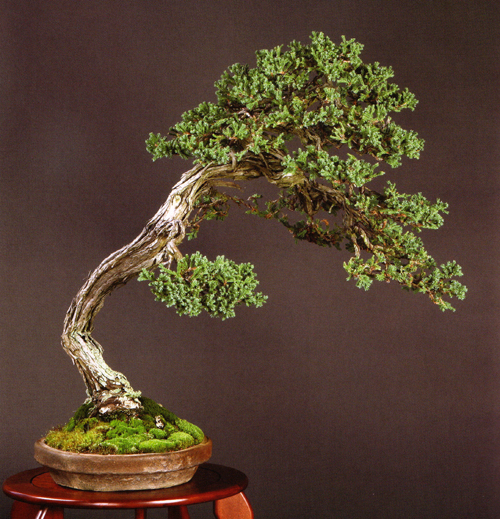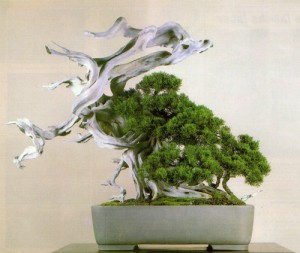
This Rough bark shore juniper is by Boon Manakitipivart. It originally appeared in Bonsai Today issue 108. Though it certainly has a rugged, natural feel, does it also have some features (aside from the pot) that are more characteristic of bonsai than of trees growing in the wild?
Is there a clear distinction?
Back two or three years ago, I was hearing and reading a lot about naturalistic bonsai versus more abstract bonsai. Though I’m not sure that the difference is always that obvious, or that there are only two categories when it come to this discussion, I do get the general idea: some bonsai look a lot like trees in nature and some look less like trees in nature. Perhaps most are somewhere in between.
What did John Naka have to say?
John Naka, the Dean of American Bonsai and a man with plenty of insight and the ability to communicate it, is said to have said “Don’t try to make your tree look like a bonsai. Rather, try to make your bonsai look like a tree.” Good advice for sure, though it may not answer all our questions.
What about Kimura?
I don’t think you’d say that Masahiko Kimura was overly concerned about making the tree below look like a tree in nature (to my eyes, the deadwood is pure sculpture and the living part looks quite naturalistic), yet I do imagine that he was concerned about capturing something about trees and nature and maybe about humans too. To me, it does express something essential about trees, and it also goes beyond just that. And it certainly goes beyond some conventional notions about bonsai (especially in the 1980s, when Kimura styled this tree).
.

This famous Shimpaku juniper is by Masahiko Kimura. It appears on the back of The Magician, the Bonsai Art of Kimura, volume 2.
What does Walter Pall have to say?
Walter Pall, a very accomplished Western bonsai artist and a man who is not afraid to express his views, has something to say on the subject as well. Stay posted and we’ll pick the subject (and Walter) up in part 2.
‘A bonsai should offer the illusion of an old tree, ravaged by time, and possessing the stigmata of natures violent forces.’ This has been said with different voices many times in different publications. However, it is a rare bonsai that actual possesses these features. For the most particulars, bonsai has features defined by the art and not nature. Elements that fall within only several standard deviations of set parameters. Rare is the bonsai that has the feel of the random and multiple effects of nature.
No bonsai artist comes closer to achieving the natural than Walter Pall and, perhaps, no one farther than Masahiko Kimura, with his unnatural “clouds” of foliage.
Yeah. I think that for most people, bonsai is an attempt to improve on nature. Even with dramatic old collected trees, almost no one would simply stick them in a pot and call them bonsai. An exception might be the Dan Robinson’s Douglas fir that will appear in our next post on the topic.
As far as Kimura goes, I’ve seen others with more unnatural clouds than even the most obvious of his. And if you look at his whole range of trees, you’ll find some that are fairly naturalistic. I think Kimura’s genius is that he has been experimenting and pushing bonsai in various directions, often with dramatic results, for a long time.